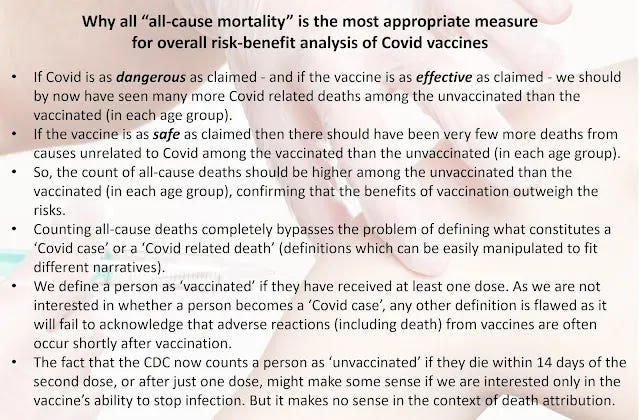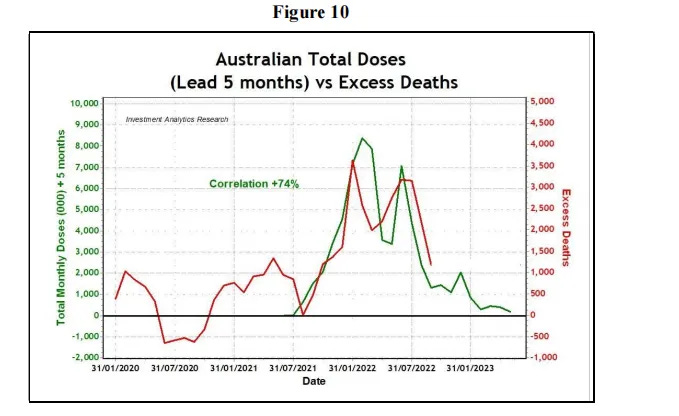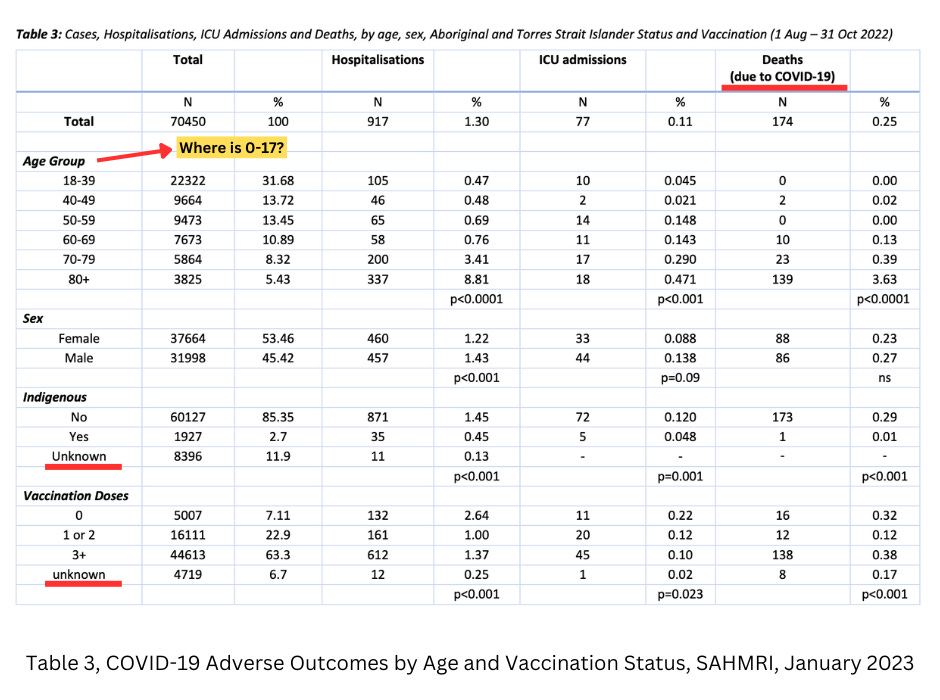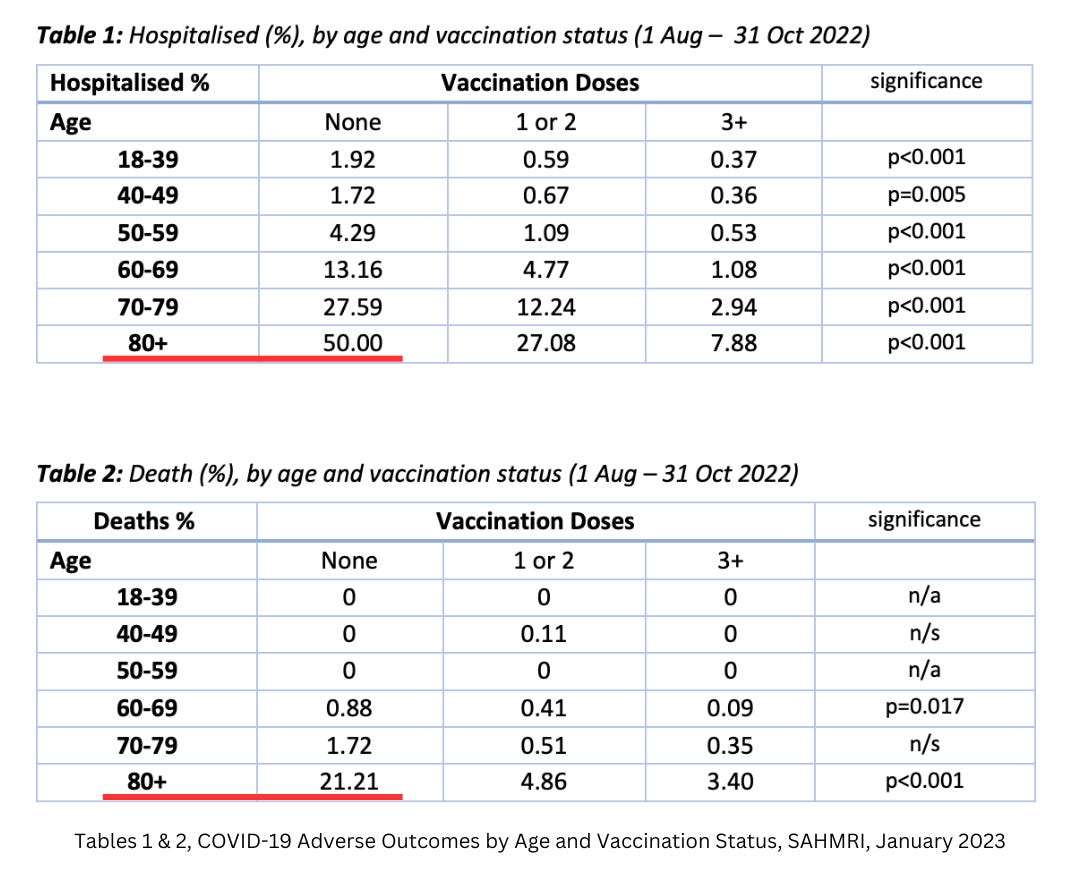Missing SAHMRI report on SA Health Covid data finally published
As predicted, it tells us nothing
A fortnight ago I reported that the South Australian government (SA Gov) was making big claims of vaccine effectiveness based on an analysis of SA Health data by research group SAHMRI. But the analysis was nowhere to be found, and enquiries to SA Gov and SAHMRI just resulted in being routed back to media materials about the mystery report.
In this post, I said,
“Whether the analysis gets published quietly in two weeks time, or never, is irrelevant at this point.
The headlines have done the rounds, and the majority of the public have absorbed the information and moved on.”
Sure enough, two weeks after being PR blitzed across the nation, the analysis has been discreetly published by SA Gov. You can find it HERE, an archived version HERE, and a PDF version attached at the end of this post.1
Prepared by University of Adelaide’s Prof Caroline Miller (also Director of Health Policy at SAHMRI) and Prof Joshua Ross, the report contains so little information that I cannot see how it can be meaningful outside of its utility as a propaganda tool.
Nevertheless, some observations:
SAHMRI finds that vaccination confers excellent protection against hospitalisation and death with Covid, with the unvaccinated languishing in hospitals or perishing at 8x and 5x the rate of the vaccinated, respectively. This is counter to the appalling outcomes of their vaccinated neighbours in New South Wales, where more doses of Covid vaccination are associated with higher rates of hospitalisation and death with Covid.
The data set includes only reported positive cases, i.e.: only those who tested positive and reported it. Of these cases, only those where the status of determined covariates was known were included. Cases excluded from the data set might include: those that were never reported; those where the infected person did not realise they had Covid; those that did report, but their race, sex, vaccination status, or age could not be confirmed. No further information is provided in the report as to how many cases were left out due to not qualifying under these criteria.
Hospitalisation and ICU data appear to be ‘with Covid’, while deaths are ‘of Covid’. The only time this distinction is made in the entire report is in Table 3, where deaths are qualified as ‘due to Covid’. As hospitalisations and ICU admissions are not notated ‘due to Covid’, I presume that they are ‘with’ Covid. Nowhere in the report is a definition provided for ‘with’ vs. ‘due to’ Covid qualification, and there is no explanation as to why ‘with’ would be used for some outcomes (hospitalisation, ICU admission), while ‘due to’ is used for the outcome of death. Strangely, while the above screenshot excerpt from the report says that cases will only be included where the status of each covariate is known, Table 3 shows that cases with unknown covariate status were included in the data set.
The data presented is incomplete and irregular. For example, there is no data for ages 0-17, age groupings are not symmetrical, and vaccination doses have been grouped together (0, 1 or 2, 3+). Further, age stratification by vaccination dose is shown for the outcomes of hospitalisation and death (Tables 1 and 2), but is not shown for ICU admissions. No explanation has been provided for the incomplete and irregular presentation of SA Health data.
Most of the deaths are aged 80+. This was known in 2020, and is still the case. According to SAHMRI analysis, the unvaccinated make up about 1/2 of those aged 80+ who are hospitalised with Covid, and about 1/5 of those aged 80+ who die due to Covid. The obvious question here is - are these geriatrics just stubborn holdouts, or were they too frail to be vaccinated? The analysis provides no insight.
Comorbidities do not appear to have been taken into account as a covariant in this analysis. That seems like a massive oversight in light of the fact that comorbidities are one of the main determinants in Covid severity and prospect of death.
A better multivariate analysis might have taken into account:
Population size by age group and vaccination status in symmetrical groupings (e.g.: 10 year age bands)
The percentage that tested positive as the percentage of the cohort population (see: Johan Ioannidis’s seroprevalence study to determine IFR)
The percentage hospitalised/admitted to ICU/died because of Covid by size of cohort population
Comorbidities
There also needs to be a proper explanation of methods used and an appendix with raw (or nearly raw) data so that readers can understand what the data looked like before SAHMRI analysed it, and how they arrived at their findings.
All-cause mortality as the appropriate measure of vaccine effectiveness
Analysing Covid hospitalisations and deaths is good and well, but it slides beside the point, according to British mathematician and expert in Bayesian analysis, Prof Norman Fenton.
Fenton argues that all-cause mortality (ACM) is the most appropriate measure of vaccine effectiveness. This is because ACM can capture both benefits and risks of Covid vaccines. If the vaccines are safe and Covid is deadly, ACM will be significantly worse for the unvaccinated. On the other hand, if the vaccines are not safe, this will be reflected in ACM for the vaccinated.

To learn more about Fenton’s case for ACM as the appropriate measure of vaccine effectiveness, and about all the statistical tricks and sleights of hand available to skillful experts, I highly recommend perusing Fenton’s blog.
A recent Covid vaccine-related analysis using Australian ACM data is Australian COVID-19 pandemic: A Bradford Hill analysis of iatrogenic excess mortality, by investment analyst Wilson Sy (2023). On conducting a thorough analysis according to the Bradford Hill criteria2, Sy finds a strong correlation between significant excess mortality and the Covid injection campaign. He concludes,
”A strong case has been presented for the iatrogenic3 origins of the Australian COVID-19 pandemic and therefore, the associated mortality risk/benefit ratio for COVID injections is very high.”

Markus Mutscheller does a good explainer of the study here:
Another fairly recent preprint, Probable causal association between Australia's new regime of high all-cause mortality and its COVID-19 vaccine rollout (Rancourt, et al., 2022), draws similar conclusions. Read a great summary of the paper by Joel Smalley, below. Joel is the Substack king of ACM analyses. He has linked to several of his Australian ACM analyses, pinned as top comment.
Analyses that exclude risks of vaccination by design aren’t really that useful, except for propaganda fodder. And on that front, the SAHMRI analysis proved to be an excellent PR asset for the SA Gov fifth dose drive.
More commentary unfolding on Twitter, with input from Jikky. Join the chat…
COVID-19 Adverse Outcomes by Age and Vaccination Status South Australian data, August – October 2022
Bradford Hill analysis criteria (Table 2), Australian COVID-19 pandemic: A Bradford Hillanalysis of iatrogenic excess mortality, February 2023:
Iatrogenesis (n): The unintentional causation of an unfavorable health condition (such as disease, injury, infection, or an adverse drug reaction) during the process of providing medical care (such as surgery, vaccination, hospitalisation, or diagnostic testing)












As you already know, I've done a few ACM analyses for Australia, though not explicitly using vax status as an explanatory variable:
1. https://metatron.substack.com/p/australia-begins-to-reap-what-it
2. https://metatron.substack.com/p/excess-deaths-in-australia-are-substantially
3. https://metatron.substack.com/p/new-south-wales-australia-covid-update
4. https://metatron.substack.com/p/dead-down-under
And there was this paper by Rancourt et al.
5. https://metatron.substack.com/p/probable-causal-association-between
Thanks for patience in dragging out this report from them. It was as I thought. All their numbers are based on results for 80+ year olds. And for the few under 80's that died we can't tell their vax status. We know they most likely had comorbidities and therefore were vaccinated. 138 deaths were 3+ doses and 16 were zero dose.
Looking forward to trawling through this report to see what trickery they used with "Bayes" logistic regression.